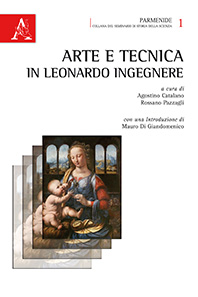Estratto da
ARTE E TECNICA IN LEONARDO INGEGNERE
Il sapere tecnico-scientifico di Leonardo come premessa del cantiere moderno
ARTE E TECNICA IN LEONARDO INGEGNERE
Il sapere tecnico-scientifico di Leonardo come premessa del cantiere moderno

Construction sites during the renaissance period were influenced greatly by Brunelleschi’s revolutionary construction site practice of separating the designer from the worker. One who supervises the construction activity, Architect / Planner / Coordinator or Director, from one who performs the hands on work, Master Mason / Masons / Carpenters / Blacksmiths and general laborers?
Differentiating from the traditional teaching of the Architect’s work shop, were the Architect and designers would work alongside and with the skilled trades. So not only were they responsible to organize the construction phase of the project, they also engaged in the construction site preparations such as temporary works, scaffolding and rigging.
Leonardo at twenty must have been stunned from what he saw when he and Verrocchio visited Brunelleschi’s construction site at S. Maria del Fiore. They were there in order to put on the lantern, the big brass ball, which was later destroyed by a lightning strike.
Brunelleschi’s dome undoubtedly represented from both an Architectural and technical point of view on of the most interesting works ever built. Leonardo was so impressed by the technical innovations required for such a structure of its size to be built which precluded the use of traditional ribbing. Impressed also by the machinery that Brunelleschi designed and built to transport and lift materials, ramps and scaffolding.
For whatever reason, Brunelleschi did not create any documentation to protect himself against imitation and or plagiarism of his inventions and machine designs. Leonardo must have studied in great depth Brunelleschi designs including the basic principles of the machinery. With inspiration from what he learned from Brunelleschi it allowed Leonardo in future years to become prophet of the modern construction site.
This paper aims to focus on how the modern construction site, in terms of technology and technical terms could be attributed to the genius of Leonardo da Vinci. His contributions include the design of machinery for lifting, slewing cranes, winches, odometers etc. Machines still used today in one way or another and in many forms, according to the requirements and needs of construction sites all around the world, all indebted to their “ancestors”. Leonardo’s studies in the fields of mechanics including pulleys, worm gears, ball bearings was his greatest contribution to this field as it led to the ground work enabling him to design such powerful machines that could drill , excavate, survey and earth moving.
To study the drawings of Codex Atlanticus alongside the history of construction equipment over the centuries will try to answer the question according to a contemporary reading, a plausible answer from the point of view of science and history.
Differentiating from the traditional teaching of the Architect’s work shop, were the Architect and designers would work alongside and with the skilled trades. So not only were they responsible to organize the construction phase of the project, they also engaged in the construction site preparations such as temporary works, scaffolding and rigging.
Leonardo at twenty must have been stunned from what he saw when he and Verrocchio visited Brunelleschi’s construction site at S. Maria del Fiore. They were there in order to put on the lantern, the big brass ball, which was later destroyed by a lightning strike.
Brunelleschi’s dome undoubtedly represented from both an Architectural and technical point of view on of the most interesting works ever built. Leonardo was so impressed by the technical innovations required for such a structure of its size to be built which precluded the use of traditional ribbing. Impressed also by the machinery that Brunelleschi designed and built to transport and lift materials, ramps and scaffolding.
For whatever reason, Brunelleschi did not create any documentation to protect himself against imitation and or plagiarism of his inventions and machine designs. Leonardo must have studied in great depth Brunelleschi designs including the basic principles of the machinery. With inspiration from what he learned from Brunelleschi it allowed Leonardo in future years to become prophet of the modern construction site.
This paper aims to focus on how the modern construction site, in terms of technology and technical terms could be attributed to the genius of Leonardo da Vinci. His contributions include the design of machinery for lifting, slewing cranes, winches, odometers etc. Machines still used today in one way or another and in many forms, according to the requirements and needs of construction sites all around the world, all indebted to their “ancestors”. Leonardo’s studies in the fields of mechanics including pulleys, worm gears, ball bearings was his greatest contribution to this field as it led to the ground work enabling him to design such powerful machines that could drill , excavate, survey and earth moving.
To study the drawings of Codex Atlanticus alongside the history of construction equipment over the centuries will try to answer the question according to a contemporary reading, a plausible answer from the point of view of science and history.
| pagine: | 107-133 |
| DOI: | 10.4399/97888548746267 |
| data pubblicazione: | Ottobre 2014 |
| editore: | Aracne |








